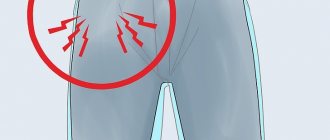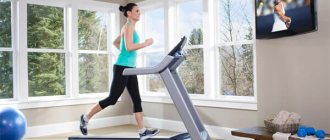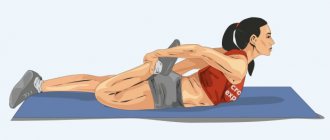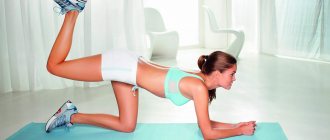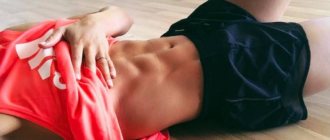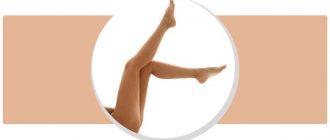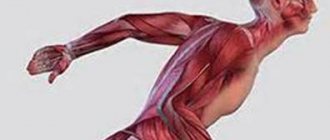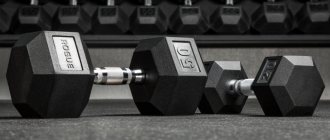Ballistic stretch
Ballistic stretching is based on short, kicking movements that push the body, arms, and legs beyond their normal range of motion.
During this “warm-up,” you stretch using a jerking technique, and the stretched muscles act like a taut bowstring that tries to return your body to its normal position. (An example would be repetitive bending toward your toes.)
This type of stretching is not considered particularly beneficial and can lead to injury. Ballistic stretching does not allow your muscles to relax and adapt to the stretched position, but instead forces them to tighten, repeatedly activating the stretch reflex.
A few words about the stretch reflex. When a muscle is stretched, the neuromuscular spindle is also stretched. The neuromuscular spindle is a receptor that detects changes in muscle length and the rate of this change and sends a signal to the spinal cord.
The spinal cord processes the information received and activates the stretch reflex, also known as the myotatic reflex, which prevents the muscle from changing length and causes the stretched muscle to contract. And the faster the length of the muscle fiber changes, the more pronounced the response muscle contraction is.
Dynamic stretching
Dynamic stretching involves moving parts of the body and gradually increases the depth of movement, speed of movement, or both. Don't confuse dynamic stretching with ballistic stretching!
Dynamic stretching consists of controlled swinging movements of your arms and legs that (gently!) push you to the limit of your normal range of motion. And ballistic stretching exploits jerking movements that force parts of the body beyond the permissible amplitude.
There is no room for jerking or jerky movements in dynamic stretching. A good example of dynamic stretching is slow, controlled swinging of the legs or arms, and twisting of the torso.
Contraindications to stretching
Stretching exercises have contraindications, and this is normal. You should not stretch if you have a cold, accompanied by fever, runny nose, or severe cough.
Main contraindications:
- fractures, cracks and other damage to the skeletal system;
- frequent dizziness, nausea;
- mental illness;
- oncology;
- unstable blood pressure;
- flat feet 3rd degree.
There are also restrictions. You should do stretching exercises with caution during pregnancy, menstruation, and the presence of osteochondrosis. We listen carefully to our body and prevent pain. If something suddenly goes wrong, we slowly stop classes, gradually get ready, and relax.
Static stretching
Static stretching is based on maintaining a stretching position. This means you stretch as far as you can and then hold the stretch position.
The passive stretching technique assumes that you are relaxed and are not actively trying to influence the range of motion; instead, the driving impulse comes from outside and is generated by a partner or mechanical device.
Static stretching is divided into two types: static-active stretching and static-passive stretching. In what follows, when we talk about static stretching, we will mean passive stretching.
Active stretching
Active stretching is also called static-active stretching. In active stretching, you take the desired position and then maintain it without assistance by tensing the agonist muscles.
For example, let’s take a lying leg raise with fixation at the top point without the help of improvised means, when you hold your legs in an extended position only with the help of your muscles. Tension of the agonist muscles during active stretching helps to relax the muscles that we want to stretch (antagonists) according to the principle of reciprocal inhibition.
Active stretching increases actual flexibility and strengthens agonist muscles. As a rule, it is quite difficult to maintain the position required for active stretching for longer than 10 seconds, and therefore stretching exercises rarely last more than 15 seconds.
Read also: How to pump up your back? 5 expert tips.
By the way, many movements (stretches) found in various variations in yoga are examples of active stretching.
Passive stretching
Passive stretching is also called relaxation stretching and static-passive stretching. In passive stretching, you take the desired position and maintain it with the help of another part of your body, or with the help of a partner or improvised means. For example, lifting your leg up and holding it at the top point with your hands.
The splits are another example of passive stretching, as in this case the floor acts as a “handy tool” that helps you stay in a stretched position. Slow, relaxing stretches help to successfully combat contracture in muscles recovering from injury.
Of course, you should first consult a doctor and make sure that everything is in order, and then you can start stretching the damaged muscles. In addition, relaxation stretches are very good for “cooling down” after strength training, as they help reduce fatigue and muscle soreness after exercise.
Abdominal stretch
Stretching the abdominal muscles is a necessary procedure after training, especially for beginners. It will help you avoid unpleasant pain in the following days and will help you not to quit classes. The rectus and oblique abdominal muscles are pulled.
Popular exercises:
- Deflection Lie on your stomach, rest your palms on the floor, raise your upper body, arch your back. Fingers point forward. Hold the stretch for 30-50 seconds.
- On a towel. Roll the towel into a tight roll up to 7 cm in diameter. Lie on your back, place a bundle under your lower back, raise your arms above your head, clasp them in a lock, and stretch.
- Stretching the side muscles. Raise your hands, clasp them behind your head, point your elbows in different directions. Lean to the left, pause. Lean to the right.
By the way, a familiar stretch for the abs is the famous “bridge” exercise. If it does not cause any difficulties, then you can safely do it!
We have prepared a list of supplements for muscle recovery after stretching and training.
Squirrels
- Protein. Large packaging will allow you to stock up on the necessary supplement for a long time.
- Protein shakes. Ready-to-drink drinks are convenient to take with you.
- Bars. A great snack that also helps with post-workout recovery.
Carbohydrates
- Brown rice An excellent source of carbohydrates that were burned during exercise.
- Quinoa. A cereal that allows you to get the right carbohydrates for the body.
Fats
- Chia seeds. A source of healthy fats from unsaturated sources that are important for the functioning of the body.
- Omega 3. Natural supplements that promote recovery.
Isometric stretching
Isometric stretching is a type of static stretching (that is, without movement) that uses counteracting the isometric contraction of the target muscle group, that is, resisting the tension of the muscle we want to stretch.
Using isometric stretching is one of the fastest ways to develop static-passive plasticity; the method is much more effective than passive stretching or active stretching alone. In addition, isometric stretching develops the strength of “tight” muscles (which helps sharpen static-active flexibility) and somewhat reduces the degree of pain that many are accustomed to associate with stretching exercises.
The easiest ways to create the resistance needed for an isometric stretch are to use resistance with your arm, a partner, or use a nearby object such as a wall or floor as a point of resistance. An example of manual counteraction would be holding the arch of the foot, preventing it from flexing while the calf muscles try to straighten the foot and pull the toes.
An example of enlisting the help of a partner to create counteraction would be for them to lift your leg up (and hold) while you try to return your leg to the ground.
An example of using a wall to generate counter force is the well-known “push the wall” exercise for stretching the calf muscles. You are trying with all your might to move the wall, although you know very well that this is impossible.
Isometric stretching is not recommended for children and adolescents who are still growing. As a rule, they are already so flexible that the strong stretch provoked by isometric contraction is accompanied by an increased risk of damage to the tendons and connective tissue structures.
Before isometric stretching, it is recommended to prepare the muscles to be stretched with dynamic strength exercises. A full set of isometric stretches places increased demands on the muscles being stretched and should not be performed more than once per day for each muscle group (ideally, no more than once every 36 hours).
The correct isometric stretching sequence is:
- Take a position for passive stretching of the target group.
- Tighten the stretched muscle for 7-15 seconds (using resistance that cannot be overcome, such as a wall or a partner).
- Relax the muscle for at least 20 seconds.
Types of stretching (stretching)
Try to understand for yourself the differences in the types of stretching, then you can use them with great effect and understanding (explanation taken from https://katerinabuida.com/7-vidov-stretchinga-rasty...).
Static Stretching
Static stretching is the most common and recommended. Take the position and hold it for 30 to 60 seconds. Frozen in a pose, you should focus all your attention on the sensations in the muscles. You should feel a gentle pulling sensation, but not pain. The main load is directed to the muscles. Gentle on tendons and joints. Stretching with your own weight, bending forward. The folds are in a vertical position, where the most important thing is to relax and “hang” with the entire weight of your top. The splits, if you are not already sitting in them, also involve relaxation, but only in the groin, and not in the knees.
Passive Stretching
Passive stretching is similar in principle to static stretching. The only difference is that with passive stretching, you don't use your own force, but instead have a partner help you.
Dynamic Stretching
dynamic stretching consists of controlled movements of the legs and arms that gently spring you through the range of your muscles' capabilities. This can be either slow (movement with emphasis) or fast movement. These can be all kinds of swings, rolls from split to split. An example of a dynamic movement is to place the palm as a target and swing into the palm, thus not going into a ballistic movement. Or make a free swing, but do not throw, but lead your leg. But this, of course, is more difficult than the palm option.
Ballistic Stretching
(Ballistics is the science of the movement of bodies thrown in space.) This is uncontrolled movement, as opposed to dynamic stretching. An example of a ballistic stretch is a springy movement with good amplitude downward several times to touch the toes in the crease. You need to be careful when using this type of stretching in the beginning. It is useful for experienced athletes and dancers.
Active Isolated Stretching
This is a stretching technique that localizes, isolates, and stretches each individual muscle. This stretching technique can be used to warm up muscles well both before and after training. It can reduce stress on joints, increase range of motion, stretch muscles, and eliminate “stiffness” that limits the range of motion of joints and muscles. It is effective to use a clothesline, belt, rope jump rope, long belt or elastic bandage for this purpose. Using this rope, you can use your own efforts to pull the part of the body that you are stretching. Active stretching is when you assume a position and then maintain the pose without any assistance, solely using the strength of your muscles. For example, raise your leg high and then hold it in this position. The tension of some muscles during active stretching helps to relax the stretched muscles (antagonists) by mutual balancing. Active stretching increases active flexibility and strengthens muscle strength.
Isometric Stretching
This is an alternation of tension and relaxation. Let's look at the example of twine. Sit in the correct position on the splits, then lower yourself until it hurts slightly and strain your leg muscles as if you want to lift yourself up using only your legs (maximum tension), hold for 20 seconds, then relax the muscles and sit lower. And so on several times.
Proprioceptive Neuromuscular Facilitation.
This involves contracting the muscle as much as possible (with the help of a partner or trainer) and then immediately performing a static stretch of the muscle. This technique is best used in conjunction with an assistant. It is important to remember that the muscle being stretched must be relaxed and rested for at least 20 seconds before performing the next exercise. There are two types of proprioceptive muscle relief stretches:
- “contraction-relaxation” (isometric muscle contraction followed by relaxation and then stretching to the maximum point) and
- “contraction - relaxation - agonist contraction” (isometric muscle contraction followed by relaxation, stretching to the maximum point and contraction of the agonist muscle, followed by stretching to the maximum). You get into a static stretched position, then contract the muscle isometrically (that is, without movement), then perform the next stretch, with a greater amplitude, thanks to the previous isometric muscle contraction and subsequent relaxation. Subsequent stretching occurs due to the fact that isometric contraction activates the Golgi apparatus, the muscle relaxes and gains the ability to stretch again.
For example, first you extend your toes and thereby strain the calf muscle, then hold this position for at least 4-10 seconds, tiring the calf due to static tension. And only then do you pull the sock toward you and stretch your calf. The fact is that muscles usually resist stretching: you try to stretch them, but they tend to return to their “shortened” state. But if the muscle is first tired by contracting, it will no longer be able to resist you. And the stretching will be perfect!
Or, if you are planning to stretch your hamstrings, you must first carefully stretch this muscle group, then contract it, overcoming resistance (yours or your partner’s). Next, you need to contract the opposing muscle group (in this case, the quadriceps). For what? According to the physiological law you already know, this will lead to relaxation of the hamstrings, which means that in the next “circle” you will be able to achieve greater stretching of these muscles. Then the cycle repeats again. Experts do not recommend using this technique for those who have had or have heart disease or hypertension.
PNF stretch
PNF stretching (a method of proprioceptive improvement of neuromuscular transmission, or relaxation after tension) is today considered the fastest and most effective way to increase static-passive flexibility.
In reality, this is not so much an independent type of stretching exercise, but a combined technique that combines passive stretching and isometric stretching to achieve maximum static plasticity. Initially, PNF stretching was developed as a method of rehabilitation of patients after a stroke.
PNF combines various post-isometric relaxation stretching techniques in which the muscle group is passively stretched, followed by an isometric contraction phase in a stretched position with resistance, and in the final phase the muscle is passively stretched again with an increased amplitude.
Typically, PNF stretching requires the participation of a partner who first creates resistance to the isometric contraction and then passively moves the joint through an even greater range of motion. Such exercises can be performed without outside help, but it should be recognized that with the participation of a partner they are more effective.
Most PNF stretches involve isometric agonist contraction/relaxation, in which the muscles being stretched sequentially contract and then relax.
Some PNF stretching techniques also involve contracting antagonist muscles, during which the antagonist muscles of the stretched muscles contract. In any case, it should be noted that the muscles being stretched must rest (and relax) for at least 20 seconds before performing the next PNF stretching technique. Below I will talk about the most common techniques for this type of stretching.
Read also: Squat technique, what is the truth.
Grip-relax
The technique is also known as contraction-relaxation. After an initial passive stretch, the muscle being stretched contracts isometrically for 7-15 seconds, then rests briefly for 2-3 seconds and is immediately subjected to a passive stretch, which stretches the muscle more than during the initial passive stretch. The final passive stretch lasts 10-15 seconds. The muscle then rests for 20 seconds before performing the next PNF stretch.
Capture-relax-contract
The technique is also known as contraction-relaxation-contraction, and contraction-relaxation-antagonist contraction. It involves the use of two isometric contractions: first the agonist contraction, then the antagonist.
The first part is similar to the previously described grip-release technique, where after an initial passive stretch, the muscle being stretched is contracted isometrically for 7-15 seconds.
The muscle then rests while its antagonist immediately begins an isometric contraction, which is held for 7-15 seconds. Next, the muscles rest for 20 seconds before moving on to the next PNF stretching technique.
Grip-relax-swing
This technique (also called catch-release-puncture) uses dynamic or ballistic stretching in combination with static and isometric stretching.
A very risky technique that can only be successfully used by experienced athletes and dancers who have achieved an amazing degree of control over muscle stretch reflexes. It is similar to the catch-release technique, except that dynamic or ballistic stretching replaces the final phase of passive stretching.
Note that in the grip-relax-contract technique there is no passive stretching phase. It is replaced by an antagonistic contraction, which, through reciprocal inhibition, relaxes and further stretches the muscle group that was the target of the original passive stretch.
Because there is no final stretch phase, this PNF stretching technique is considered one of the safest to perform (less likely to tear muscle tissue). Many people like to make this technique even more effective by incorporating a passive stretch phase after the second isometric contraction, and while this can speed up the development of flexibility, it also increases the risk of injury.
Even more risky is dynamic or ballistic stretching integrated into PNF stretching techniques, such as grab-release-swing or grab-release-punch.
Unless you are a professional athlete or dancer, you should not even attempt these techniques (the risk of injury is too high). Even professionals should not use these techniques without the guidance of a professional trainer or experienced mentor.
These two techniques have the greatest potential for rapidly increasing flexibility, but only when performed by people who have sufficient control over the stretch reflex in the muscles being stretched.
PNF stretching is not recommended for children and people whose skeletal system continues to grow (for the same reasons). Along with isometric stretching, PNF stretching helps strengthen contracting muscles and is therefore well suited for increasing both active and passive flexibility.
And, as with isometric stretching, PNF stretching requires a tremendous amount of tension and should therefore be applied to each muscle group no more than once per day (ideally, no more than once in a 36-hour period).
The basic guidelines for PNF stretching are as follows: Perform your chosen stretching techniques 3-5 times for each muscle group, resting 20 seconds between repetitions.
And in order to reduce the duration of stretching sessions without compromising their effectiveness, it is recommended to do only one PNF stretching exercise for the target group within one training session.
When done correctly, stretching will do more than increase your flexibility. Benefits of stretching include:
- Improvement of general physical fitness
- Increased ability to master and perform exercises requiring flexibility
- Improved mental and physical relaxation
- Improving your understanding of your body
- Reduces the risk of injury to joints, muscles and tendons
- Reduced muscle soreness
- Reducing muscle contractures
- Increasing the elasticity and plasticity of connective tissue structures by stimulating the production of chemical compounds that lubricate connective tissue.
- Reducing the intensity of menstrual pain in women
Unfortunately, even a person who stretches regularly does not always do so correctly, and therefore often does not receive much of the benefits of good stretching. The most common mistakes during stretching exercises:
- improper warm-up
- insufficient rest between sets
- overextension
- poor choice of exercises
- performing exercises in the wrong (or non-optimal) sequence
Stretching. How to avoid injury by stretching
Translator: Maria Smeshkova
Editor: Veronica Rees
Source: National Center for Biotechnology Information
This article was published on the website: CMT - Scientific approach
A hamstring strain is one of the most common exercise injuries. It occurs in 12-16% of athletes, with the incidence of re-injury reaching 22-34%.
Such injuries usually occur during sports activities that involve sudden acceleration or deceleration and fast running. They are associated with eccentric contraction of the muscles of the hip joint, which occurs in the final phase of the movement and promotes slow extension of the knee. To avoid injury, muscles are most often stretched before training. But does it help?
Let us remind you that a lack of elasticity of the hamstring muscles (HH) can lead to muscle imbalances, which, in turn, provokes injuries to the musculotendinous complex, tendinitis of the knee joint, patellofemoral pain and the appearance of lower back pain.
Stretching is often performed during the warm-up before major exercises to increase joint mobility—the ability of a joint to move in all planes through a full range of motion—reduce muscle and tendon stiffness, and optimize movement. Athletes practice various stretching techniques such as:
- static - all exercises are performed statically;
- dynamic - exercises are performed dynamically, but in a controlled manner;
- ballistic - dynamic, uncontrolled, sharp, jerky execution of exercises;
- PNF (proprioceptive neuromuscular facilitation) - exercises in which, through resistance, the muscle, being in an elongated state, tenses and then passively relaxes.
It is static stretching, in which the target muscle is held in an elongated position for a certain period, that is believed to reduce the stiffness of the muscle-tendon complex and increase stretch tolerance. But researchers have concerns that static, ballistic stretching and PNF may reduce muscle strength, repetitions and vertical jump height. It has been noted that if static stretching is used as the only tool, it can be harmful.
Dynamic stretching, in which the part of the body being stretched moves through the entire possible range of motion through the work of antagonists, is known to increase muscle strength, sprinting speed, vertical jump performance and the quality of golf shots.
As a result, dynamic stretching has become recommended as a pre-workout warm-up.
However, while some studies show that dynamic stretching improves joint movement, others show its effect on the stiffness of the muscle-tendon complex. Additionally, it has been suggested that the increase in joint range of motion observed after dynamic stretching is due to adaptation to stretch rather than a decrease in muscle and tendon stiffness.
Because stretching exercises are typically performed 15 to 60 minutes before the start of a competition or physical activity, it is important not only to understand the effects of dynamic stretching on musculotendinous complex stiffness and stretch tolerance, but also to examine the long-term effects of these effects.
Study
Researchers conducted a study to examine the effects of dynamic stretching of the musculotendinous muscles on the range of passive knee extension, on knee joint torque before the onset of pain (as a measure of stretch tolerance), and on passive stiffness of the muscle-tendon complex over a long period after the stretch.
The researchers hypothesized that dynamic stretching, performed prior to core exercise, specifically improves the functioning of the PCL muscles by increasing knee extension, torque, and decreasing passive stiffness. Also, the effect on passive stiffness will not last as long as changes in extension range and torque.
Participants
The scientists recruited 24 healthy people between the ages of 20 and 23 and assigned them sequentially to either the experimental or control group. There were 6 men and 6 women in both groups, similar in parameters such as age, height, weight and BMI. All participants were selected based on a screening test that confirmed that they were unable to fully straighten the knee from the starting position (Figure 1).
There were no differences between groups in mean hip flexion and knee flexion angles at baseline.
Figure 1. a) Position for passive knee extension testing using an isokinetic dynamometer. The left picture is the starting position with the knee and hip joint at approximately 110° of flexion. Right picture - the knee is passively extended until the subject feels pain (maximum knee extension). b) curves showing data before and after dynamic stretching. Stiffness was determined using a regression line between 50% and 100% of the ratio of ranges of motion and torque at the knee joint before stretching
Potential participants who had undergone hip or lower extremity joint surgery, had neurological abnormalities in the lower extremities, or were taking hormones and/or medications that could affect their muscle function were excluded.
also no athletes .
Additionally: see this detailed analysis by Boris Tsatsouline of the basic rules of safe and effective stretching.
Progress of the study
Study participants were advised not to change their habits and refrain from exercise two days before the start of the study. The experiment was conducted in a university temperature-controlled laboratory at 26°C.
Passive knee extension amplitude, pre-pain torque, and passive hamstring stiffness were measured using an isokinetic dynamometer before and after dynamic stretching, as shown in Figure 1.
Measurements were taken in the experimental group before dynamic stretching (pre) and after time - 0, 15, 30, 45, 60, 75 and 90 minutes after dynamic stretching (post). Similar data were taken from the control group, whose participants did not do dynamic stretching.
Effect of Dynamic Stretching
Each study participant dynamically stretched their right leg. It was dominant in all 24 participants in the experiment - through a survey, it was found that all of them kicked the soccer ball with their right foot.
Figure 2. A - initial standing position; B - hip flexor contraction
The warm-up was omitted to avoid any effect on stretching. Participants were asked to stand up straight, place their legs parallel to each other, and grasp parallel bars with both hands (starting standing position). Subjects were then asked to lift their leg and contract their hip flexors without bending their knee every 2 seconds (the hamstrings are stretched).
Each participant performed 5 slow repetitions of this exercise to master the technique. They then performed 10 fast repetitions at maximum amplitude to the rhythm of a digital metronome set at 30 beats per minute, without bouncing. Dynamic stretching was performed for 5 minutes and included ten 30-second sets with 20 seconds of rest in between.
During rest, the subjects took their original standing position. 5 minutes of dynamic stretching (DR) was chosen because previous studies have shown that 5 minutes of static stretching at moderate intensity and without pain increased range of motion and torque, and also decreased passive stiffness of the MR muscles after exercise.
results
Although there were no significant long-term changes in the outcome measures of the control group, they were present in all measures .
- In the experimental group, immediately after DR, passive extension was increased by an average of 8.1° (from 6.8° to 11.5°), 10% compared to the initial values.
- The significant increase in amplitude was maintained for 90 minutes and remained 9.4% greater than before DR after 90 minutes.
- Likewise, torque increased by 9.7% immediately after DR. However, it is worth considering that the indicators 30 minutes after the exercises were practically no different from the indicators before the exercises.
- Passive stiffness decreased by 7.9% immediately after DR, remained lower than the control group at 90 minutes, and was 13.4% lower than the pre-DR value at 90 minutes.
conclusions
Researchers have found clear and consistent effects of dynamic stretching on several parameters of flexibility in the pelvis muscles in healthy volunteers.
Dynamic stretching promotes a sustained decrease in passive stiffness of the knee joint, an increase in passive knee extension, and a slower increase in knee torque..
Dynamic stretching of the ST muscles before exercise can help prevent common injuries, as increased passive stiffness of the ST muscles and decreased knee extension range are risk factors for injury to the ST muscles during sports.
The reduction in passive stiffness after DR persists for ≥ 90 minutes afterwards. And after passive stretching, the decrease in passive stiffness of the triceps surae muscle lasts 12-20 minutes, the muscles of the hamstrings - less than 60 minutes.
Additionally: read this article about how stretching affects the athletic performance of professional athletes and untrained people.
Warm up before training
A standard warm-up should begin with rotations in the joints, starting from the tips of the toes and moving up, or from the fingers and going down. This simplifies joint movements due to the uniform lubrication of all articular surfaces with synovial fluid.
Read also: How to overcome a training plateau: 4 ways.
This lubrication helps your joints cope more easily with their functional responsibilities during the main workout. You should perform slow circular movements, both clockwise and counterclockwise, until the movement in the joint becomes completely smooth. You should work the following joints (in the suggested or reverse order):
- Fingers and metacarpophalangeal joints
- Wrists
- Elbows
- Shoulders
- Neck
- Torso and lower back
- Hip area
- Hip
- Knees
- Ankles
- Toes
By the end of the warm-up, you will have warmed up your muscles and they will become more elastic. Immediately after your general warm-up, you should perform a slow, relaxing, static stretch. Start with the back, followed by the upper body and lower body, stretching the muscles in the following sequence:
- Back
- Sides (external obliques)
- Neck
- Forearms and wrists
- Triceps
- Breast
- Buttocks
- Groin area (adductors)
- Hips (quadriceps and abductors)
- Ankles
- Shin
- Posterior thigh
- Foot
You will find exercises for static stretching of all these muscles in many books on stretching. Unfortunately, not everyone has the time to stretch all of the listed target groups before each workout.
But even if you are limited in time, be sure to find an opportunity to stretch the muscles that you plan to load during the training session.
Stretching before and after training
Once again about the need to warm up before training
Both after sleep and after a busy day, your muscles may be quite stiff and your joints may not be flexible enough.
During the main training, this can lead to injuries: muscle strain and tendon inflammation in runners, shoulder damage in bodybuilders, lower back pain in yoga practitioners. The Lifehacker Telegram channel contains only the best texts about technology, relationships, sports, cinema and much more. Subscribe!
Our Pinterest contains only the best texts about relationships, sports, cinema, health and much more. Subscribe!
Stretching exercises before your main workout will help avoid injury. However, doing a couple of bends towards your toes is not enough to ensure the necessary level of metabolism. Have you noticed how your performance only improves halfway through your workout? Count the time before you warmed up.
Warm up before, not during, the main workout
The optimal warm-up time is 15–20 minutes. The first 10 minutes should be a good time to warm up your muscles:
- light jogging;
- jumping rope;
- squats without weights;
- bench press
After this, you can move on to stretching exercises.
Vadymvdrobot/Depositphotos.com
Static and dynamic stretching
During static stretching, the pose is held for more than 30 seconds with a gradual increase in muscle stretch to the maximum. Complete relaxation and stretching of the muscle occurs only after 30–60 seconds.
In the case of dynamic stretching, the exercise is performed in constant motion, and an increase in amplitude is achieved through repeated repetitions of short (3-5 seconds) movements.
An important point: when performing both static and dynamic stretching, movements should be smooth, with a gradual increase in amplitude and without pain.
So which stretching exercises should you choose for your workout?
During warm-up - dynamic stretching
First, constant movement during dynamic stretching will keep your body warm.
Second, static stretching before your main workout can reduce performance. Excessive muscle relaxation can lead to slower speed in runners or poor balance in bodybuilders.
Perform dynamic exercises, holding the pose for no more than 5 seconds, doing 4-6 repetitions.
Particular attention should be paid to exercises that imitate the movements of the main workout (1-2 exercises, 15-20 repetitions).
Approximate plan for working out the whole body:
- Neck: rotation of the head, turns left and right, tilts up and down.
- Shoulders: up and down movement, circular movements, swinging your arm to the side.
- Back and chest: stretching your back with your arms clasped in front of you and moving your arms back to open your chest.
- Arms: circular movements in the shoulder and elbow joints.
- Body: tilts left-right, down, twists at the waist and rotation of the pelvis.
- Legs: circular movements of the knees, lunges to the side and forward, circular movements of the feet, bends towards the feet.
Static stretching - during cool down
Static stretching exercises will relax tense muscles and help remove waste products from them faster, which will allow you to recover faster.
Pay special attention to the muscles that were targeted in your workout, the ones that buzz the most.
Each approach should take at least 30 seconds. In this case, you should feel traction, but not pain. Breathe regularly and deeply, this will help achieve maximum results.
It is important that where you perform static stretching is not cold: only in warmth will the muscles be able to relax sufficiently.
rognar/Depositphotos.com
Results
- Dynamic stretching before your main workout will help warm up your muscles and reduce the risk of injury - 5-10 minutes of short exercises for the entire body from head to toe.
- Static stretching after exercise will help with relaxation and recovery - stretch for 30-60 seconds on each particularly tight muscle.
- The main rule: stretching exercises should be performed without sudden jerks and pain.
Finish your workout wisely
Proper completion of a workout does not come down to just stretching. This is just part of the process. Once you've completed a training session, the best way to reduce muscle fatigue and soreness (caused by lactic acid production during maximal or submaximal muscle exertion) is to return to stretching exercises. As a result, the final part of the workout will be similar to the second half of your warm-up, only in reverse order.
The final part of the training includes three phases:
- Relevant physical activity
- Dynamic stretch
- Static stretch
Ideally, you should begin the final part of your workout with 10-20 minutes of relevant physical activity, the intensity of which will be slightly higher than in the warm-up. However, in real life you may not have 20 minutes to cool down at the end of a training session, however, you should devote at least 5 minutes to a specific activity.
Relevant athletic activity should be immediately followed by stretching: first perform light dynamic stretching exercises until your heart rate returns to normal, and then move on to static stretching.
Relevant sports activity followed by stretching will relieve muscle spasms, reduce muscle tension, soreness and fatigue, and you will feel much better.
Light exercises that complete the workout, immediately following training with a maximum load, more effectively cleanse the muscles and blood of lactic acid than completely passive rest.
Moreover, if you experience muscle soreness the next day, a light warm-up can be a great way to relieve sore muscles and relieve tension, even if you don't exercise immediately after your workout.
Quite often there are sensations that indicate that you have reached the maximum level of stretching. This is indicated by symptoms such as localized warmth in the stretched muscle, followed by a burning sensation (like a cramp) and sharp pain ("dagger" pain).
Local heat usually occurs at the point of maximum permissible stretch of the muscle. When you begin to feel it, you should take a “step back” and reduce the intensity of the stretch.
If you ignore (or don't feel) this heat, you get closer to the point where a burning sensation occurs in the muscle being pulled. At this moment you should stop the exercise immediately!
You may not feel pain yet, but it will definitely come the next day. If you stretch to the point of acute pain, it is likely that the stretch has already caused damage to the muscle tissue, which causes immediate pain and does not go away for many days.
Now you know everything about stretching. And there's no reason why you should avoid it!
Stretching after contraction
This form of stretching involves contracting the muscle being stretched or its antagonist immediately before the stretch. The most common option is PNF stretching. Postisometric relaxation (PIR) is also distinguished. This technique is characterized by significantly less intense muscle contraction (25%) followed by stretching. Post-facilitation stretching is a technique developed by Vladimir Janda that involves a mid-range maximal muscle contraction with a rapid movement toward maximum length, followed by 15 seconds of static stretching.
Stretching based on PNF
Stretching the Pectoral Muscles Using PNF Techniques
There are several variations of the techniques, all of which involve stretching the muscles to the limit. This causes a reverse myotatic reflex, i.e. a protective reflex that relaxes muscles to prevent injury. Regardless of the technique, this type of stretching can be used on various muscles of the body. PNF stretches can be modified so that you can do them on your own or with a partner.
Stretching options:
- Contraction-relaxation is an isotonic muscle contraction followed by relaxation and stretching.
- Hold-relaxation is an isometric muscle contraction followed by relaxation and stretching.
- Contraction-relaxation-antagonist contraction - isotonic contraction of the agonist muscles, followed by contraction of the antagonist muscles to stretch the target muscles.
